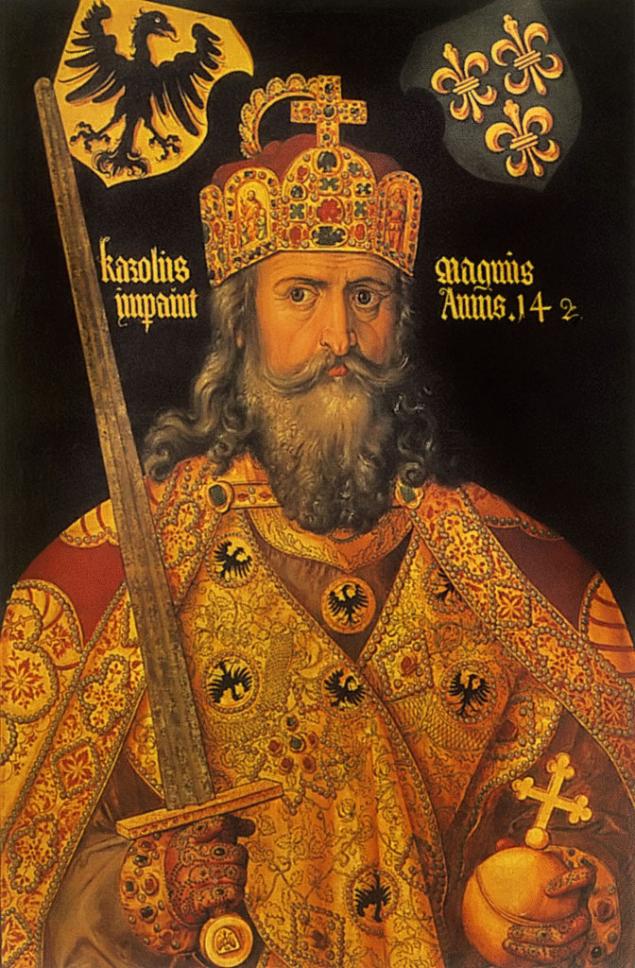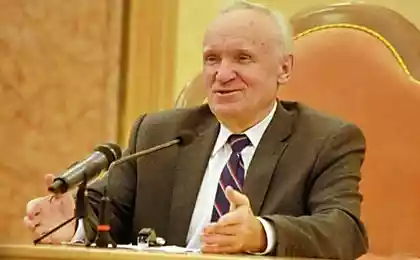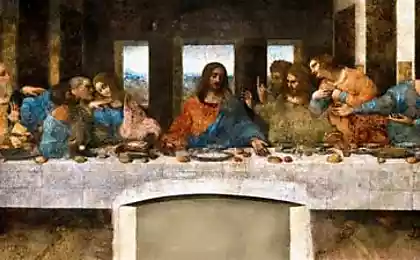575
What happened three centuries?
From early Western European middle ages have survived remarkably little information from credible sources. To determine the reliability of any fact, historians have to compare a number of indirect evidence. To set the exact date medieval events — harder every puzzle, because consistent historical records of the early period of the Middle ages does not exist. The few documents that clearly dated often struck by the very fantastic chronology or contain some incredible numbers.

The Holy Roman Emperor Otto III. Miniature from the gospel
If you have patience and dig in the libraries of old monasteries, you can find there a lot of notes allegedly of the X century, which is provided with a date retroactively. From a modern point of view, such documents look inept crude forgery. Personal notary of the Holy Roman Emperor for some unknown reason, the document 700 years fixed date in the year 1000, "jumping" thereby using
three ages!
Between 614 and 911 years formed a space: three hundred years interval did not have any reliable documentary evidence, like it never was! The modern German historian Heribert Illig came to the conclusion that the reign of Holy Roman Emperor Distillate III and Pope Sylvester II is marked in the annals of history three centuries later than it actually was. Such grave "mistakes" could not have arisen by chance, for them, of course, there were good reasons.
Before the last judgment
But why should the German king and the Pope to falsify historical dates? In the Christian calendar 1000 year seemed particularly significant: he noted the onset of the last period of time before the last judgment. Otto III sought to unite Christian Europe around Rome and the Holy Church. It was profitable together with the Pope to proclaim that "this is the last time", and threaten a Terrible judgment have forgotten the God of the Christians.
But to practically "transfer time" for three centuries to come, the Emperor and the Pope not only had to correct the date on multiple documents, which almost no one had access. They did more — filled fictional historical events 297 years, which was not. So there was a colorful narrative that is marked with dates from 614 to 911. These manuscripts are more like tales and legends, than a dry, dispassionate presentation of the facts, made a good-faith monks chroniclers.
Charlemagne and the deer
In one such imaginary chronicle is told of Charles the Great, the legendary founder of the first European Christian dynasties. In support of his property rights and the power of the emperors of the Holy Roman Empire, including Otto III, who referred to Charlemagne — his unparalleled courage, unlimited power, abundance and splendor of the yard.

The story of the Foundation of the legendary monarch of Zurich are presented in the form of a report about a real event. Charlemagne and his retinue went hunting and tracked a magnificent buck deer. Hunters on horseback rushed in pursuit of swift-footed animals, but deer, as luck would have sped the distance on the green spaces. Royal entourage without feeling tired, miraculously rode from Aachen to the place where now lies the Zurich (now the highway is more than six kilometers, in addition, it was necessary to cross the river). In the picturesque Alpine valley of the deer stopped in his tracks. The king immediately realized that this is no accident. He ordered to dig up the ground in the place, and it turned out that there lie the remains of Christian martyrs. Over the graves of Christians built a Church, and churches around the city — Zurich.
In other manuscripts it is said that Charlemagne summoned the nobles of different countries. The record of this event, too, has little in common with the real facts.
The messenger of the Caliph gave the host a gift of a spear. The Emperor took the spear, raised his hand and dokinuli it to Byzantium (!). The spear landed in the dome of Hagia Sophia in Constantinople, bounced off and flew back — right into the Royal hand of Charlemagne.
Clever trick
Otto III, to strengthen his own power, seemed more significant those episodes of legends of Charles the Great, where king showed incredible strength and valor. The only military campaign had the irresistible Karl, to defeat all the enemies in Europe, not only the "infidels" — filthy Gentile and powerful at that time, Byzantium. Superhuman deeds of his legendary ancestor was easy to silence any real enemy. Ancestors, kinship and marriage ties meant in feudal Europe more than the individual qualities of a personality.
As to the date "911", in this case, according to Heriberto Illiga, medieval forgers came up with a clever trick. It is impossible simply to add to the current date 300 years, so nobody noticed...
Shifted reference point
For clarity, we refer to even more ancient times: the decision of the First Ecumenical Council Dionysius Small calculated new Paschal, that is made up of the annual calendar of the celebration of Easter. Dionysius in his calculation of Easter for the first time revealed the date of a new era — 525 a year from Christmas.
To the Paschal Dionysius Small in Europe, used the chronology of Diocletian, named after the Roman Emperor Diocletian brutally persecuted Christians. It took centuries to years from the birth of Christ has become in European countries generally accepted. By the beginning of the reign of Otto III chronology from the birth of Christ is already widely came into use, and all dates previously specified in the "era of Diocletian", it was necessary to recalculate anew. The Emperor outwitted his contemporaries: when translating dates from the old calendar to the new he added 300 years and thus moved point of reference.
The witness of the era – architecture
Reliable and long-lasting witnesses of the era are stone buildings. In the architecture of some buildings of the early middle ages too it is possible to notice a strange inconsistency — inconsistency advanced buildings technology of his time. For example, the medieval Cathedral in Aachen dated this "missing" and tampered with time. According to the documents, the oldest part of the Cathedral — Royal chapel of Charles the Great — was built around 800 ad Specialists recognize this building a true masterpiece of architecture, created using the engineering knowledge and construction technologies that correspond to IX and XII century.
In the year 800, builders in Aachen already knew the techniques that their colleagues invent and learn in 300 years. Methods of stone processing, construction of domes and arches, the horizontal distribution of gravity huge roof, able to withstand the force of wind, the technology of masonry walls, the basic layout of the building, this Cathedral presents features of the early Gothic style that emerged in Western European architecture in the second half of the XII century.
In Germany there is almost no architecture of the period from 614 to 911 by year (for 300 years nothing was built, but the Royal chapel?). The falsification of Otto III proves also the "disappearance" of the Andalusian cities in the Moorish style of the same period. In the written sources of expressive painted amazing luxury huge Moorish town with cobbled streets and even streetlights. It's amazing: from the beautiful Moorish palaces and left not a single stone, and the surviving buildings date from (modern methods) most early — 950 year.
Fictional events, mysterious facts...
Once a meticulous researcher delves into the study of all aspects of life during the "missing" 300 years, it certainly falls within the scope of false statements, fictional events, mysterious facts, and legendary figures.
Heribert Illig cites an interesting parallel in different calendars. Events in medieval Persia is very difficult to bind to the corresponding period of European history. We can rely on a few well-known facts. In 641 Persia was conquered by the Arabs and began to spread there Islam instead of Zoroastrianism. But even in the X century Persia, especially its Eastern part, has not yet become a Muslim country. Maybe sultans of the Arab Caliphate showed no inherent religious tolerance and did not prevent subjects to worship the Sun?
Classical Persian poet Ferdowsi Abulkasim lived from about 940 at the 1020 or 1030. In the epic poem "Shakhname" he described the history of the Iranian Kingdom from the fourth century until the Arab conquest. The author dedicated his work to the Sultan, although none of the 60 thousand couplets makes no mention of Arab heroes and conquerors, no Great Allah. If we ignore the three hundred years, as an invention of Otto III, then slowed the spread of the Muslim religion in Persia became more or less clear.
The Iranians did not want to accept Islam, he left his homeland. The Persians-Zoroastrians settled in India are called Parsis and there are considered like a separate caste. In the East Iran and neighbouring countries have a small number of Zoroastrians, has preserved its ancient pagan religion. Religious communities of Iranian Zoroastrians can't understand why the calendar for their fellow Christians living in India are Parsis, 300 years differs from the calendar adopted in Iran and other countries. Gone to India the Persians in their communities consider the years still, without moving time for three hundred years.
Now is not 2014, but the year 1714?
One can only speculate as to the Distillate III occurred voluntarily to compose three centuries of history. Otto III came to the throne in 995 the age of 15, and January 23, 1002, he has died as quite a young man. Times were tough in southern Europe came the Saracens, the Arabs, and has advanced so far that threatened the German lands. In the North hosted the pagan Vikings and Slavs, who utterly ruined severogermanskim city.
Young Otto III was for its time an educated man with a broad Outlook. He had the idea to make Rome capital of the world, to unite around Rome the whole of Christian Europe. Otto III most of the time spent in Rome, came up with a lavish ceremony and titles, wore a mantle embroidered with signs of the zodiac. Fantastic idea connects him with the religious bigotry posts, prayers and mortification of the flesh. In Italy, the young Emperor found many followers, the pious Christians, who disliked the atmosphere of General debauchery and the pursuit of carnal pleasures.
Pope Sylvester II, a protege of Otto III, too was a young idealist. He was very different from their immediate predecessors, because in the X century the papacy was not a Bastion of faith and morals. The clergy enjoyed great authority and lived in pleasure, not indulging in worldly pleasures. Greed and lust monks became legendary. Why unite the European Nations around the Rome?
To proclaim the nearness of the last judgment, to get people to think, to remember about God and his commandments — the idea is naive, but essentially well-intentioned. In any case, it's absolutely in the character of Otto III. In the mind of the young monarch wandered bold ideas, ambitious plans. He had some knowledge about the world, but he lacked the sense of reality and life experience. Unifier of Christians, a champion of morality, fanatic faith — he was in the clouds and could hardly realize something is planned, even if he lived longer. At the end of life Otto III already no one to lean on, he had no supporters.
Such a person is able, without hesitation, to set the clock for three hundred years and come up with the missing story of three centuries. If it's true, the inimitable Otto III really fixed a date and confuse him to contemporaries and descendants, so now we have the court 1714!
Galina SIDNEVA
источник:skylineru.net
Source: /users/1077

The Holy Roman Emperor Otto III. Miniature from the gospel
If you have patience and dig in the libraries of old monasteries, you can find there a lot of notes allegedly of the X century, which is provided with a date retroactively. From a modern point of view, such documents look inept crude forgery. Personal notary of the Holy Roman Emperor for some unknown reason, the document 700 years fixed date in the year 1000, "jumping" thereby using
three ages!
Between 614 and 911 years formed a space: three hundred years interval did not have any reliable documentary evidence, like it never was! The modern German historian Heribert Illig came to the conclusion that the reign of Holy Roman Emperor Distillate III and Pope Sylvester II is marked in the annals of history three centuries later than it actually was. Such grave "mistakes" could not have arisen by chance, for them, of course, there were good reasons.
Before the last judgment
But why should the German king and the Pope to falsify historical dates? In the Christian calendar 1000 year seemed particularly significant: he noted the onset of the last period of time before the last judgment. Otto III sought to unite Christian Europe around Rome and the Holy Church. It was profitable together with the Pope to proclaim that "this is the last time", and threaten a Terrible judgment have forgotten the God of the Christians.
But to practically "transfer time" for three centuries to come, the Emperor and the Pope not only had to correct the date on multiple documents, which almost no one had access. They did more — filled fictional historical events 297 years, which was not. So there was a colorful narrative that is marked with dates from 614 to 911. These manuscripts are more like tales and legends, than a dry, dispassionate presentation of the facts, made a good-faith monks chroniclers.
Charlemagne and the deer
In one such imaginary chronicle is told of Charles the Great, the legendary founder of the first European Christian dynasties. In support of his property rights and the power of the emperors of the Holy Roman Empire, including Otto III, who referred to Charlemagne — his unparalleled courage, unlimited power, abundance and splendor of the yard.

The story of the Foundation of the legendary monarch of Zurich are presented in the form of a report about a real event. Charlemagne and his retinue went hunting and tracked a magnificent buck deer. Hunters on horseback rushed in pursuit of swift-footed animals, but deer, as luck would have sped the distance on the green spaces. Royal entourage without feeling tired, miraculously rode from Aachen to the place where now lies the Zurich (now the highway is more than six kilometers, in addition, it was necessary to cross the river). In the picturesque Alpine valley of the deer stopped in his tracks. The king immediately realized that this is no accident. He ordered to dig up the ground in the place, and it turned out that there lie the remains of Christian martyrs. Over the graves of Christians built a Church, and churches around the city — Zurich.
In other manuscripts it is said that Charlemagne summoned the nobles of different countries. The record of this event, too, has little in common with the real facts.
The messenger of the Caliph gave the host a gift of a spear. The Emperor took the spear, raised his hand and dokinuli it to Byzantium (!). The spear landed in the dome of Hagia Sophia in Constantinople, bounced off and flew back — right into the Royal hand of Charlemagne.
Clever trick
Otto III, to strengthen his own power, seemed more significant those episodes of legends of Charles the Great, where king showed incredible strength and valor. The only military campaign had the irresistible Karl, to defeat all the enemies in Europe, not only the "infidels" — filthy Gentile and powerful at that time, Byzantium. Superhuman deeds of his legendary ancestor was easy to silence any real enemy. Ancestors, kinship and marriage ties meant in feudal Europe more than the individual qualities of a personality.
As to the date "911", in this case, according to Heriberto Illiga, medieval forgers came up with a clever trick. It is impossible simply to add to the current date 300 years, so nobody noticed...
Shifted reference point
For clarity, we refer to even more ancient times: the decision of the First Ecumenical Council Dionysius Small calculated new Paschal, that is made up of the annual calendar of the celebration of Easter. Dionysius in his calculation of Easter for the first time revealed the date of a new era — 525 a year from Christmas.
To the Paschal Dionysius Small in Europe, used the chronology of Diocletian, named after the Roman Emperor Diocletian brutally persecuted Christians. It took centuries to years from the birth of Christ has become in European countries generally accepted. By the beginning of the reign of Otto III chronology from the birth of Christ is already widely came into use, and all dates previously specified in the "era of Diocletian", it was necessary to recalculate anew. The Emperor outwitted his contemporaries: when translating dates from the old calendar to the new he added 300 years and thus moved point of reference.
The witness of the era – architecture
Reliable and long-lasting witnesses of the era are stone buildings. In the architecture of some buildings of the early middle ages too it is possible to notice a strange inconsistency — inconsistency advanced buildings technology of his time. For example, the medieval Cathedral in Aachen dated this "missing" and tampered with time. According to the documents, the oldest part of the Cathedral — Royal chapel of Charles the Great — was built around 800 ad Specialists recognize this building a true masterpiece of architecture, created using the engineering knowledge and construction technologies that correspond to IX and XII century.
In the year 800, builders in Aachen already knew the techniques that their colleagues invent and learn in 300 years. Methods of stone processing, construction of domes and arches, the horizontal distribution of gravity huge roof, able to withstand the force of wind, the technology of masonry walls, the basic layout of the building, this Cathedral presents features of the early Gothic style that emerged in Western European architecture in the second half of the XII century.
In Germany there is almost no architecture of the period from 614 to 911 by year (for 300 years nothing was built, but the Royal chapel?). The falsification of Otto III proves also the "disappearance" of the Andalusian cities in the Moorish style of the same period. In the written sources of expressive painted amazing luxury huge Moorish town with cobbled streets and even streetlights. It's amazing: from the beautiful Moorish palaces and left not a single stone, and the surviving buildings date from (modern methods) most early — 950 year.
Fictional events, mysterious facts...
Once a meticulous researcher delves into the study of all aspects of life during the "missing" 300 years, it certainly falls within the scope of false statements, fictional events, mysterious facts, and legendary figures.
Heribert Illig cites an interesting parallel in different calendars. Events in medieval Persia is very difficult to bind to the corresponding period of European history. We can rely on a few well-known facts. In 641 Persia was conquered by the Arabs and began to spread there Islam instead of Zoroastrianism. But even in the X century Persia, especially its Eastern part, has not yet become a Muslim country. Maybe sultans of the Arab Caliphate showed no inherent religious tolerance and did not prevent subjects to worship the Sun?
Classical Persian poet Ferdowsi Abulkasim lived from about 940 at the 1020 or 1030. In the epic poem "Shakhname" he described the history of the Iranian Kingdom from the fourth century until the Arab conquest. The author dedicated his work to the Sultan, although none of the 60 thousand couplets makes no mention of Arab heroes and conquerors, no Great Allah. If we ignore the three hundred years, as an invention of Otto III, then slowed the spread of the Muslim religion in Persia became more or less clear.
The Iranians did not want to accept Islam, he left his homeland. The Persians-Zoroastrians settled in India are called Parsis and there are considered like a separate caste. In the East Iran and neighbouring countries have a small number of Zoroastrians, has preserved its ancient pagan religion. Religious communities of Iranian Zoroastrians can't understand why the calendar for their fellow Christians living in India are Parsis, 300 years differs from the calendar adopted in Iran and other countries. Gone to India the Persians in their communities consider the years still, without moving time for three hundred years.
Now is not 2014, but the year 1714?
One can only speculate as to the Distillate III occurred voluntarily to compose three centuries of history. Otto III came to the throne in 995 the age of 15, and January 23, 1002, he has died as quite a young man. Times were tough in southern Europe came the Saracens, the Arabs, and has advanced so far that threatened the German lands. In the North hosted the pagan Vikings and Slavs, who utterly ruined severogermanskim city.
Young Otto III was for its time an educated man with a broad Outlook. He had the idea to make Rome capital of the world, to unite around Rome the whole of Christian Europe. Otto III most of the time spent in Rome, came up with a lavish ceremony and titles, wore a mantle embroidered with signs of the zodiac. Fantastic idea connects him with the religious bigotry posts, prayers and mortification of the flesh. In Italy, the young Emperor found many followers, the pious Christians, who disliked the atmosphere of General debauchery and the pursuit of carnal pleasures.
Pope Sylvester II, a protege of Otto III, too was a young idealist. He was very different from their immediate predecessors, because in the X century the papacy was not a Bastion of faith and morals. The clergy enjoyed great authority and lived in pleasure, not indulging in worldly pleasures. Greed and lust monks became legendary. Why unite the European Nations around the Rome?
To proclaim the nearness of the last judgment, to get people to think, to remember about God and his commandments — the idea is naive, but essentially well-intentioned. In any case, it's absolutely in the character of Otto III. In the mind of the young monarch wandered bold ideas, ambitious plans. He had some knowledge about the world, but he lacked the sense of reality and life experience. Unifier of Christians, a champion of morality, fanatic faith — he was in the clouds and could hardly realize something is planned, even if he lived longer. At the end of life Otto III already no one to lean on, he had no supporters.
Such a person is able, without hesitation, to set the clock for three hundred years and come up with the missing story of three centuries. If it's true, the inimitable Otto III really fixed a date and confuse him to contemporaries and descendants, so now we have the court 1714!
Galina SIDNEVA
источник:skylineru.net
Source: /users/1077
The Internet of things won't work without artificial intelligence
Baba ganoush — spicy appetizer of baked eggplant





















